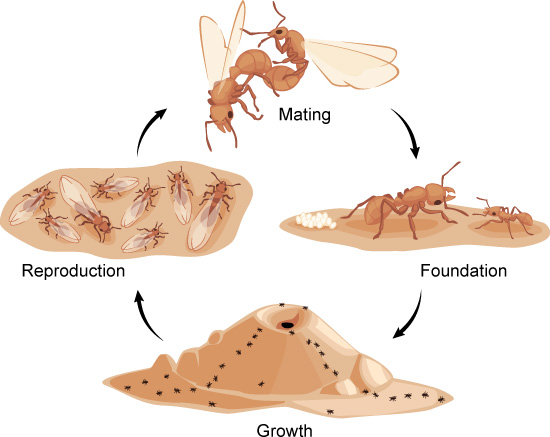show/hide words to know
Founding Stage: after mating, a queen (or queens) starts a new nest and raises her first worker offspring.
Growth Stage: the colony grows larger by producing more workers, which perform all tasks except reproduction.
Reproductive stage: when the colony reaches a critical size (usually takes several years), it produces new queens and males, which fly away to mate with ants from other colonies and start the next generation.
Life Cycle of an Ant Colony

An ant colony begins in the founding stage. After mating, the queen(s) starts a new nest and raises her first worker offspring. This is the only time in a queen’s life that she does work in addition to laying eggs.
During the growth stage, the colony grows larger by producing more workers. The workers now perform all the colony’s jobs except laying eggs. This period may last for several years.
When the colony grows large enough, it enters the reproductive stage. Now the colony produces new queens and males. These winged adults fly away to mate with ants from other colonies. The queens then start the next generation of colonies. Colonies may reproduce year after year until their queen(s) dies.
View Citation
Bibliographic details:
- Article: Life Cycle of an Ant Colony
- Author(s): Tate Holbrook, Rebecca Clark, and Brian Haney
- Publisher: Arizona State University School of Life Sciences Ask A Biologist
- Site name: ASU - Ask A Biologist
- Date published: December 21, 2009
- Date accessed: January 12, 2025
- Link: https://askabiologist.asu.edu/ant-colony-life-cycle
APA Style
Tate Holbrook, Rebecca Clark, and Brian Haney. (2009, December 21). Life Cycle of an Ant Colony. ASU - Ask A Biologist. Retrieved January 12, 2025 from https://askabiologist.asu.edu/ant-colony-life-cycle
Chicago Manual of Style
Tate Holbrook, Rebecca Clark, and Brian Haney. "Life Cycle of an Ant Colony". ASU - Ask A Biologist. 21 December, 2009. https://askabiologist.asu.edu/ant-colony-life-cycle
Tate Holbrook, Rebecca Clark, and Brian Haney. "Life Cycle of an Ant Colony". ASU - Ask A Biologist. 21 Dec 2009. ASU - Ask A Biologist, Web. 12 Jan 2025. https://askabiologist.asu.edu/ant-colony-life-cycle
MLA 2017 Style
Be Part of
Ask A Biologist
By volunteering, or simply sending us feedback on the site. Scientists, teachers, writers, illustrators, and translators are all important to the program. If you are interested in helping with the website we have a Volunteers page to get the process started.










